
Using a Keg as a CO2 Source for Portable Serving!
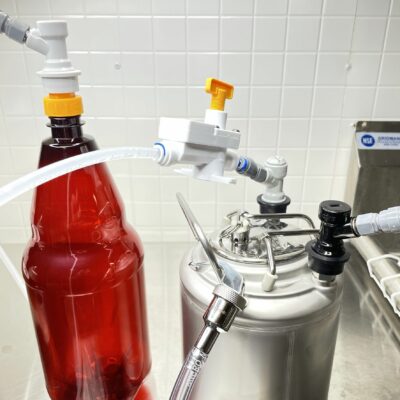
This technique uses an economical inline secondary regulator to utilize a spare keg (or growler)as a CO2 source to serve a keg. I’m not suggesting this setup as a replacement for your kegerator CO2 tank. You still need a standard CO2 tank. What this setup could be very useful for is as a replacement for those expensive little regulators or injectors and expensive (considering how much CO2 you get) little CO2 cartridges. One inexpensive purchase allows you to pressurize and serve your keg on the go for little to nothing.
Side Note: I’ve wanted to do this for years. There used to be a commercial sanke keg that had two chambers. One was used as a pressure chamber and the other held beer. I always wanted one of those. The problem was that it was extremely expensive and I just couldn’t justify the expense. This magic little secondary regulator makes something similar easily possible.
The Hardware That Makes This Possible…
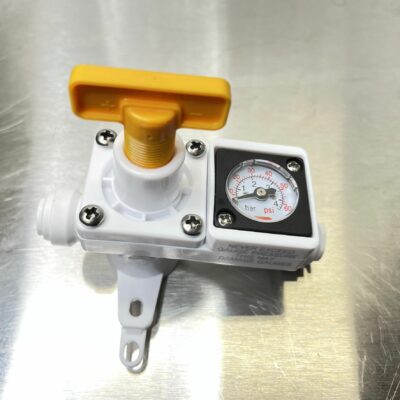
Kegland’s economical inline secondary regulators!
- Duotight In-Line Regulator | Built-In Pressure Gauge | 0-60 PSI | Liquid & Gas Compatible | 8 mm Duotight D1047 – via MoreBeer
- Duotight In-Line Regulator | Built-In Pressure Gauge | 0-150 PSI | Liquid & Gas Compatible | 6.35 mm Duotight D1093 – via MoreBeer
- Duotight Regulator with 60 PSI Gauge – via William’s Brewing
- Amazon – Search DuoTight Inline Regulator to shop around
- HKNNSDEED Home Brewing Push , Regulator Wine Accessories, for Water Or Gas – 8mm (5/16″ Push in) Home Brew – affiliate link, note that multiple variations of this product may be available, as such a different version may appear at this link – Note that this appears to being the Kegland Inline Secondary by looking at the picture
Related: Hands on Review: Kegland Inline Secondary Regulator
This article contains affiliate links. We may make a small percentage if you use our links to make a purchase. You won’t pay more and you’ll be supporting Homebrew Finds and more content like this. Thank you for your support!
Upgrade to Digital!
Kegland has released a digital gauge option that works with their great inline secondary regulator and BlowTie Spunding Valve. They have also released a DuoTight version.
- Learn More! Hands on Review: Kegland Digital Gauges
- Digital Illuminated Mini Regulator Gauge 0-90 PSI – via William’s Brewing
- Digital Mini Pressure Gauge (0-90 psi) D1165 – via MoreBeer
Primary intended Use… Multi-Pressure Serving
Maintaining multiple CO2 pressures in your kegerator gives you the ability to… keep kegs at different pressures. This is a requirement to maintain different carbonation levels. It’s also handy if you want to force carbonate a keg more quickly, at a higher pressure, while maintaining your standard serving pressure on a keg that’s already being served or if you want to have a utility line for purging kegs and such.
The general options for pulling this off are…
- A multi-pressure primary CO2 regulator – example. This has two (or potentially more) high pressure bodies that allow you set different pressures.
- Secondary CO2 regulators – example. These have no ability to connect to a CO2 tank directly. They must be connected to a compatible primary.
Both good options, but generally expensive. Kegland Inline secondary regulators are, comparatively cheap and give you loads of flexibility.
This post explores and alternate use of these regulators Adapting compatible containers to use as a pressure source for portable serving.
Other Requirements
A vessel to store CO2 (a Keg or Compatible Growler), tubing and fittings.
Important: Do not exceed stated pressures for any of your equipment. I’ll take it a step further and suggest that you don’t even get close to max pressures.
But first, more about DuoTight!
Kegland’s DuoTight Fittings are designed to work with EVABarrier Double Wall Tubing. They offer quick, reliable connections, easy implementation, a variety of fitting options and feature amazing versatility. They’re also, generally speaking, very well priced. DuoTights are push to connect fittings and require no tubing clamps.
Check out my extensive Hands on Review
Using a DuoTight v2 With Gauge to Pressurize a Keg for Portable Serving
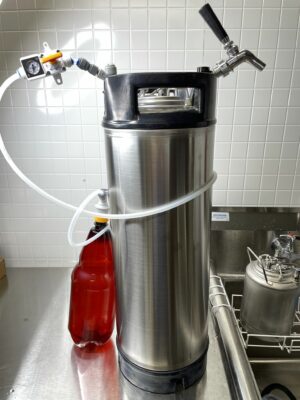 This setup shows a 5 gallon keg being pressurized by a 2.5L Growler – Hands on Review
This setup shows a 5 gallon keg being pressurized by a 2.5L Growler – Hands on Review
Because v2 with Gauge – via MoreBeer – via William’s Brewing… has a gauge, it’s a lot easier to use than our v1 setup (see below). The fact that it’s DuoTight compatible also makes it a lot easier to setup vs v1.
This setup is as follows
- 2.5L Growler – Hands on Review – pressurized to about 35 PSI – Important: Do not exceed stated pressures for any of your equipment. I’ll take it a step further and suggest that you don’t even get close to max pressures. – Note: Any suitable pressure capable container can be used here. See below for some ideas.
- Carbonator Cap – via MoreBeer, via William’s Brewing – This piece would not be needed if you’re using a keg.
- DuoTight to Flare Fitting
- Gas Keg QD
- EVABarrier Tubing
- Inline Regulator with Gauge – via MoreBeer – via William’s Brewing
- Small Piece of EVABarrier Tubing
- DuoTight to Flare Fitting
- Gas Keg QD
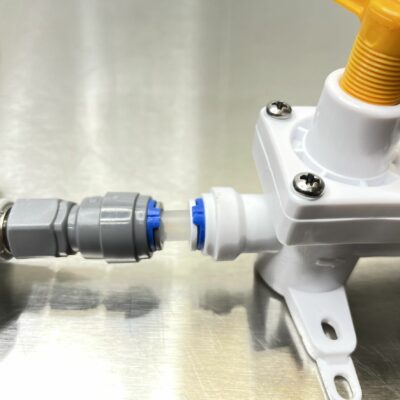 Like many DuoTight Fittings the two DuoTight Inline Secondary Regulator Models are compatible with Valuebrew’s locking clips. I used to think of those as optional, but now use them on every connection. They provide back pressure on the collar making a firmer connection and locking it in.
Like many DuoTight Fittings the two DuoTight Inline Secondary Regulator Models are compatible with Valuebrew’s locking clips. I used to think of those as optional, but now use them on every connection. They provide back pressure on the collar making a firmer connection and locking it in.
But Does It Work?
This keg was pressurized to serving pressure of 10 PSI prior to starting this test. It produced a good flow rate for most of the test. A 2.5 Liter growler reliably served about half this 5 gallon keg. A 2.5 or 3 gallon keg can easily and reliably serve an entire 5 gallon keg well below typical psi limits.
CO2 Vessel Ideas:

- Although it’s not setup as a pressure source, the pictured growler size ball lock (it’s actually 96 ounces according to my testing) would make a dandy pressure source. You should generally be able to vend 2.5 or 3 gallons with this Corny Keg – 64 oz Ball Lock Keg KEG443 via MoreBeer – Review
- 2.5 Liter PET Growler Bottles – via William’s Brewing – Review
- Any fully functioning and appropriately spec’d spare keg you have around – See our Keg Deals Roundup for recent deals.
- 2.5 and 3 gallon kegs are nice because they’re small and should be able to easily vend an entire 5 gallon keg.
- 2½ Gallon KegLand Kegs
- Corny Keg – 2.5 Gallon Ball Lock Keg KEG416
- Corny Keg – NEW (2.5 gallon) KEG419 – AEB Review
- 2.5 Gallon Ball Lock Torpedo Kegs KEG422
- AMCYL 2.5 Gallon Keg – AMCYL Review
- 2.5 gallon kegs at cornykeg.com
- 3 gallon kegs at cornykeg.com
- Beverage Elements has lots of 2.5 to 3 gallon keg options from both AMCYL and AEB in singles and multi-packs.
How much CO2 did the pressure keg hold?
From my post, Kegging CO2 Use Estimations and Calculations – We can use the The “weight of CO2 used for serving a keg” formula to estimate this. That formula is (Serving Pressure + Atmospheric Pressure) x 1/2 x Keg Volume
So, for this 2.5 gallon keg at 50 PSI, those numbers would be…
- (50 + 14.7) x 1/2 x 2.5 = 80.87 grams or 2.85 ounces
Serving estimates: 1 x 5 gallon keg at 10 PSI serving pressure, 2 x 5 gallon kegs at 5 PSI serving pressure
For a 5 gallon keg at 50 PSI, those numbers would be…
- (50 + 14.7) x 1/2 x 5 = 161.74 grams or 5.7 ounces
Serving estimates: 2 x 5 gallon keg at 10 PSI serving pressure, 4 x 5 gallon kegs at 5 PSI serving pressure
Cost Savings!
Beyond the hardware savings of using this cheap inline regulator for this purpose, this technique should save you money on CO2.
MoreBeer’s CO2 Injector uses 16 gram cartridges. As of this posting those cost $10 for 6. That figures to $1.67 each. You need between 2 to 5 cartridges to serve a 5 gallon keg of beer. Let’s just use 3 for our estimations, that’s less than the average of those two numbers.
3 x $1.67 = $5.01 for each keg you serve
Versus The keg as a CO2 source method
In my example the 2.5 gallon keg at 50 PSI keg holds approximately 2.85 ounces (the equivalent of just over (5) 16 gram cartridges). 2.85 ounces is about .178 lbs. I pay $25 for 20 lbs of CO2. That figures to $1.25 per lb.
.178 lbs x $1.25/lb = 22 cents per 5 gallon keg
Decrease serving pressure to 5 PSI and you should be able to serve 2 x 5 gallon kegs with the same amount of CO2. That would be 11 cents per 5 gallon keg
Side Note: You need about 29 x 16 gram cartridges to get 1 lb of CO2. At $1.67 per 16 grams that equates to about $48 per lb of CO2. That means 20 lbs costs about… $1,200. I pay about $25 for 20 lbs of CO2 via tank exchange. This is for the purpose of illustration only, I’m not suggesting anyone uses these in that quantity.
How about serving your kegs for $0 CO2 costs? Keep reading…
Conclusions
This economical inline regulator is a great little piece of equipment. Beyond it’s generally intended use of letting you easily serve multiple pressures and carbonation levels, it let’s you put spare kegs in use for serving on the go and saves you money on CO2.
Check Current Price, Specifications & Availability
- Duotight In-Line Regulator | Built-In Pressure Gauge | 0-60 PSI | Liquid & Gas Compatible | 8 mm Duotight D1047 – via MoreBeer
- Duotight In-Line Regulator | Built-In Pressure Gauge | 0-150 PSI | Liquid & Gas Compatible | 6.35 mm Duotight D1093 – via MoreBeer
- Duotight Regulator with 60 PSI Gauge – via William’s Brewing
- Amazon – Search DuoTight Inline Regulator to shop around
- HKNNSDEED Home Brewing Push , Regulator Wine Accessories, for Water Or Gas – 8mm (5/16″ Push in) Home Brew – affiliate link, note that multiple variations of this product may be available, as such a different version may appear at this link – Note that this appears to being the Kegland Inline Secondary by looking at the picture
How about $0 in CO2 Costs to Serve Kegs on the Go??
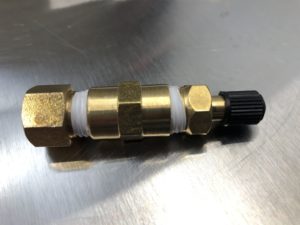 With the right fittings, you can add a Schrader type valve to your keg [See: Adding a Schrader Valve to a Homebrew Keg]. Doing so allows you to use your air compressor to pressurize the pressure keg.
With the right fittings, you can add a Schrader type valve to your keg [See: Adding a Schrader Valve to a Homebrew Keg]. Doing so allows you to use your air compressor to pressurize the pressure keg.
Important: It’s very important that you know the pressure ratings of everything you’re using. Do not exceed stated pressures. I’ll take it a step further and suggest that you don’t even get close to stated pressures.
This technique involves using your compressor to fill the pressure keg, using atmospheric air to serve your keg. Compressors could also potentially expel non food grade lubricants. I’d suggest contacting your compressor’s manufacturer to inquire about your specific model.
Before you comment, email, tweet, etc [8 ways to connect] to me, PLEASE READ THIS….
Yes, this will cause oxidation given enough time. No, I am not recommending this for any long term arrangement.
If you’re sure you’re going to go through an entire keg quickly. Quickly to me means under several hours. Oxygen will cause oxidation, but those effects should be slim to none in the span of a short period of time. If you aren’t sure the beer will be consumed quickly, use CO2.
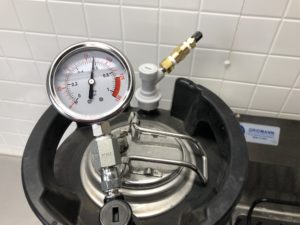 This keg has a pressure rating of not to exceed 130 PSI. Both the lid and the keg are stamped with that rating. My air compressor has a max pressure of 125 PSI. Even though the vessel itself is rated for 130 PSI, the PRV started to noticeably vent at about 90 PSI. The keg eventually leveled off at about 85 PSI.
This keg has a pressure rating of not to exceed 130 PSI. Both the lid and the keg are stamped with that rating. My air compressor has a max pressure of 125 PSI. Even though the vessel itself is rated for 130 PSI, the PRV started to noticeably vent at about 90 PSI. The keg eventually leveled off at about 85 PSI.
I’ll use my CO2 estimation formula to estimate the amount of pressurized atmosphere this keg is holding. Not sure if that is as applicable, but my guess is that it is still a valid estimation.
(85 + 14.7) x 1/2 x 2.5 = 124.63 grams or 4.39 ounces
Parts for Schrader Valve Conversion:
- Milton (S-684-4) 1/4″ MNPT Male Tank Valve
- Anderson Metals Brass Pipe Fitting, Coupling, 1/4″ x 1/4″ Female Pipe
- LASCO 17-6783 1/4-Inch Female Flare by 1/4-Inch Male Pipe Thread Brass Adapter
- Dixon Valve TTB75 PTFE Industrial Sealant Tape, -212 to 500 Degree F Temperature Range, 3.5mil Thick, 520″ Length, 3/4″ Width, White
Buy DuoTight
- DuoTight Push In Fittings & EVABarrier Double Wall Draft Tubing at MoreBeer
- Search MoreBeer for “DuoTight” – to find components and accessories that may not show up on category pages.
- Kegland DuoTight Fittings and Accessories at William’s Brewing
- Search William’s Brewing for “DuoTight” – to find components and accessories that may not show up on category pages.
- Search Amazon for “DuoTight” – offerings vary
- Search Amazon for “EVABarrier Tubing” – offerings vary
- DuoTight Compatible Locking Clips via Valuebrew
Related DuoTight Reviews on How-To’s!
DuoTight Reviews, Resource Posts & How-To’s!
DuoTights are so amazing – at least in my book 🙂 – that I have several reviews and related top posts
- Hands on Review: Kegland Inline Secondary Regulator!
- Hands on Review: Kegland DuoTight Rigid Joiners
- Hands on Review: Kegland DuoTight Ball Lock QDs!
- Troubleshooting and Fixing DuoTight Leaks
- Hands on Review: Kegland DuoTight Fittings!
- Hands on Review: Kegland BlowTie Spunding Valve!
- Hands on Review: Kegland Digital Gauges!
- Build a DuoTight CO2 Gas Manifold! – for Kegland EVABarrier Tubing
- Five Benefits of Using Corny Kegs As Fermenters
- Hands on Review: Kegland Ball Lock Cleaning Kit and Party Pump
- Hands on Review: Nukatap Counter Pressure Bottle Filler!
- Building a Simple Ball Lock Draft Line Flushing Setup
I Recommend These for DuoTight Fittings!
duotightclipsDuoTight Hands on Review!
duotightreviewRelated Resources
- Build a Spunding Valve! – How and Why
- Setting Economy Inline Regulators with a Spunding Valve Gauge
- Adding a Schrader Valve to a Homebrew Keg
- Hands on Review: William’s Brewing Inline CO2 Regulator
- Balancing Your Draft System
- Portable Draft Beer Serving Options
More CO2 Related:
- Check Your CO2 Regulator for Leaks!
- What’s the difference between Primary and Secondary CO2 Regulators?
- Get a Bigger CO2 Tank… Save Time and Money!
- Using a CO2 Detector in Your Kegerator
- The Most Difficult Spot to Check for CO2 Leaks
- Build a DuoTight CO2 Gas Manifold! – for Kegland EVABarrier Tubing
- Checking for Draft System CO2 Leaks – Using The Pressure Gauge Method
- Step by Step: Finding and Fixing Keg CO2 Leaks
- Kegging CO2 Use Estimations and Calculations
- Making a Utility CO2 Line Using Luer Lock Disconnects
More Homebrew Finds!
- Last 50 Finds!
- Top Deals – a curated list of the best deals
- Homebrew Reviews – one of the largest libraries of homebrew reviews in existence!
- Our Top Posts – tips, how-tos, resources posts and more
- Let’s be Friends!
Recent Deals!
Also: Kegerator Tips & Gear | Keg Repair Part #s | Recent Keg Finds
Our Top Draft Resources!
Check our our Top Draft Related Resources- Commentary: Pin Lock Keg Pricing and Availability
- Check Your CO2 Regulator for Leaks!
- How to get a keg ready for first use? New Keg Cleaning and Prep
- Portable Draft Beer Serving Options!
- Pin Lock Keg Pricing and Availability
- The Most Difficult Spot to Check for CO2 Leaks
- Keg O-Ring Materials Selection! – EPDM, Silicone and Buna-N?
- Why Do I Have Bubbles in My Beer Line? Diagnosing and Fixing Kegerator Foam Problems
- Five Benefits of Using Corny Kegs As Fermenters
- Rebuilding & Reconditioning Homebrew Kegs!
- Food Safe Replacement Keg O-Rings in Bulk
- Hands on Review: Kegland DuoTight Fittings & EVABarrier Tubing!
- Why Won’t My Beer Carbonate? Fixing Draft Beer Carbonation Problems
- What Does a Flow Control Faucet Do?
- Upgrade Your Kegerator – 6 Improvements!
- Serve Homebrew on Any Kegerator & Convert Commercial Kegerator to Homebrew
- Tips and Gear for Growler Filling
- What’s the Difference Between Ball Lock Kegs and Pin Lock Kegs?
- Checking for Draft System CO2 Leaks – Using The Pressure Gauge Method
- Tip: Consider Oetiker Stepless Clamps for Kegerator Gas and Beer Lines
- Hands On Review: Inkbird ITC-308 Dual Stage Temperature Controller +WiFi Version
- Universal Poppets Tips and Tricks!
- Convert Your Mark II Keg & Carboy Washer to a Recirculating Draft Line Cleaning Pump!
- Step by Step: Finding and Fixing Keg CO2 Leaks
- Kegerator Temperature Probe Placement – To Immerse or Not To Immerse? – three tests to determine optimal pla…
- Kegerator Beer Line Temperatures & Reducing Foam with a Recirculating Fan
- Kegging CO2 Use Estimations and Calculations
- Balancing Your Kegerator Draft System
- Building a Simple Ball Lock Draft Line Flushing Setup
- Build a Recirculating Draft Line Cleaning Pump
- Home Brew Keg Roundup – New & Used, 5 and 2.5 Gallon & More!
- Damp Kegerator? Fix Kegerator Condensation
- Homebrew Temp Controller Roundup! – Kegerator and Fermentation – concepts, applications and models
- Bulk Keg Orings and Keg Parts Reference
This post may contain affiliate links. We may make a commission when you use our links. This will never cost you extra. Thank you for supporting Homebrew Finds!
greatdealsImportant: It’s very important that you know the pressure ratings of everything you’re using. Do not exceed stated pressures. I’ll take it a step further and suggest that you don’t even get close to stated pressures.
Make sure the components you use are compatible and rated for your intended application. Contact manufacturer with questions about suitability or a specific application. Always read and follow manufacturer directions. tag:lnksfxd top:kegasco2 tag:tpr
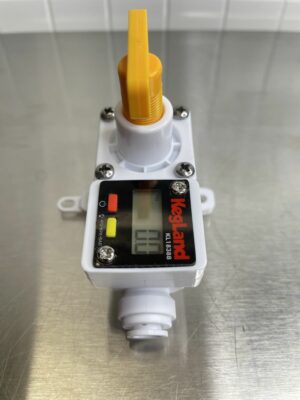



Such a great idea! I’m going to try this technique for carbonating and serving kegs that I keep outside in the winter when there is no room in my keezer. Now I can have 5 beers on tap inside and another 5 outside without having to buy another tank and regulator.